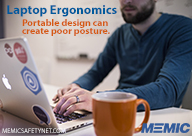Laptop Ergonomics
Today almost everyone is connected to the electronic world. School children, young and middle aged workers, and older workers are all using portable electronic devices for school, work, and social media interaction.
These activities are very common and sometimes necessary, but are also exposing our bodies to different strains. The lack of movement with prolonged poor posture can contribute to a lifetime of discomfort.
Laptop computers pose a difficult ergonomic challenge. The portable design, although convenient, can create early unconscious patterns of poor posture. When a child or young worker is using a laptop, even if they are sitting at a desk or table, the screen is too low and the keyboard and mouse devices are often too high. If you curl up on the sofa, easy chair, or in a bed for hours while using a laptop the posture issues become more severe.
Students or young workers are more tolerant of this forward head posture and flat or extended back because of their youth. As their youth wanes the process of aging settles in. Those practiced postures of their youth, good or bad, are difficult to change. They sit in a “C” shaped posture with a forward head reaching for the keyboard and mouse. Often they are not comfortable and can’t figure out why. Use of a laptop or any small input device has had them in awkward posture for extended periods of time. This becomes unconscious behavior and a habit. This, in turn, increases the strain to the neck and back.
We fight the forces of gravity everyday and the only way to reduce this strain is stand up tall, stay physically active, and improve posture. Start by:
- Using a separate keyboard and mouse.
- Utilize a standing area or desk with an adjustable chair. Yes, standing and working on a computer can be a good thing. This puts less strain on the low back. A stool can be added to allow the option of sitting or standing.
- Discuss the importance of good sitting posture and encourage workers to get up frequently and take stretch breaks. Walking during lunch breaks or taking the stairs instead of the elevator can be helpful as well.
Balancing our bodies is a lot like riding a bicycle; it’s easier when it’s moving. We are not built to sit still for extended periods of time. For more information, policyholders can use the MEMIC Safety Director, or anyone can reference the OSHA Ergonomic Solutions E-Tool.


